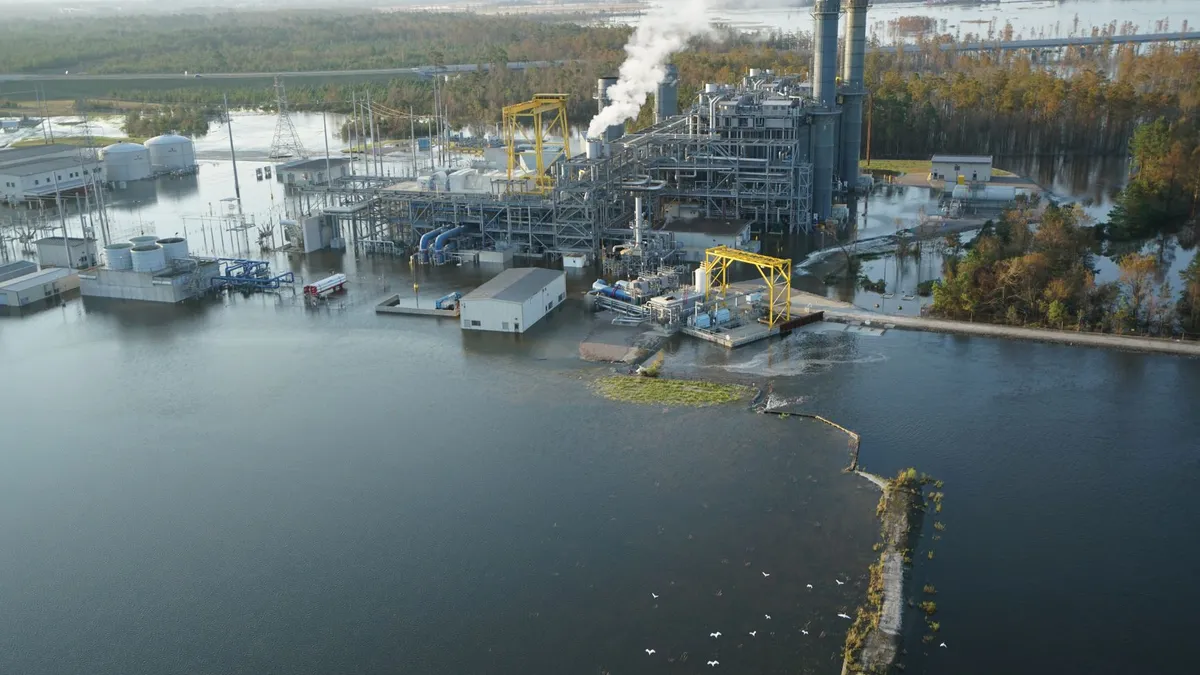Dive Brief:
-
Duke Energy shut down its L.V. Sutton natural gas plant on Friday after floodwaters from Hurricane Florence led to a dam breach at a cooling lake near the site.
-
The utility says storage pits near the facility, formerly a coal plant, may be leaking toxic coal ash into the nearby Cape Fear River. Flooding continued throughout the weekend and riverkeepers collected samples of what they believe to be coal ash from the river to be tested this week, although the utility maintains there is no discernible harm to the water downstream based on its own testing.
- Duke had issued a high level emergency alert Thursday morning due to flooding in Sutton Lake, which compounded the spill of more than 2,000 cubic yards of coal ash from the Sutton plant earlier this week.
Dive Insight:
Storing coal ash near waterways poses liability risks for utilities and pollution risks for the surrounding communities. Coal ash waste contains heavy metals, such as arsenic and mercury, and has been linked to cancer.
The breach is among four sites of concern after the slow-moving Hurricane Florence, downgraded to a Category 1 storm last week, barraged the south Atlantic coast with torrential rains. Duke's retired H.F. Lee plant, one of the threatened sites, leaked coal ash into the surrounding area during Hurricane Matthew in 2016.
Paige Sheehan, Duke's director of policy and environmental communications, told Utility Dive Thursday that the Cape Fear river's flow through Sutton Lake, was "not a concern to the surrounding area" and would lead to "no changes in the surrounding water," but the utility now says the breach may be leaking coal ash into the river.
The spill earlier this week may have leaked pollutants into Sutton Lake, though the utility said "[t]here is no visible ash." The lake is used as a cooling pond for the Sutton gas plant, but it is state-owned and protected under the Clean Water Act.
Duke Energy's Sutton facility has been a site of concern since 2013 monitoring data found groundwater near the plant was beginning to flow toward drinking water sources in the area and 2015 tests found coal ash contamination at the site. The utility faced a $25 million fine from the state and in 2015 North Carolina regulators stepped in again, mandating Duke excavate the plant's coal ash storage site and transition to dry storage.
An onsite landfill was constructed to hold the excavated ash and its failure to stand up against Florence's floodwaters earlier this week indicates it "wasn't constructed well enough," Frank Holleman, a senior attorney at the Southern Environmental Law Center, told Utility Dive.
More importantly, the landfill shouldn't have been located near waterways in the first place, Holleman said.
The utility hasn't been focused on "long term consequences for the compan[y] and the communities, so they postpone decisions to drive out litigation or cap sites," Holleman said. "It's dangerous and foolish," he said, to leave storage sites vulnerable to storms that are becoming more typical along the southeastern coast, in part due to warming waters.
Several environmental groups also say they've documented evidence of three flooded coal ash ponds near Duke's shuttered Lee coal plant near the Neuse River. The situation echoes the 2016 spill near the same plant during Hurricane Matthew, where Duke admitted to a spill but said the amount of ash released was no larger than "the bed of an average pickup truck."
The environmental groups took water samples from the sites on Wednesday, which will be analyzed within the week to determine the extent of the spill.
Duke plans to excavate all of its coal ash pits by 2029 to meet North Carolina's mandate, but it's unclear if the Lee site will be excavated before then, Sheehan said, even after the second displacement of ash at that site in recent years.
Another site of concern is Duke's retired Weatherspoon plant, located near the Lumbar River, where 2.2 million tons of coal ash is currently stored. The fate of those ash pits is still unknown, according to Holleman.
Finally, Holleman noted Santee Cooper's Granger site in South Carolina is an area of concern. On Saturday, the utility reported floodwaters from the nearby Waccamaw River were inundating one of its emptied coal ash pits and the continuously rising waters may soon threaten Granger as well, which holds 200,000 tons of coal ash.
The threatened site was one of the first to begin the excavation process after Santee Cooper was sued in 2012 because it was found to have levels of arsenic pollution and because of its proximity to the river. Granger was also threatened during Hurricane Matthew and Santee Cooper has since removed 300,000 tons of coal ash from the site, "implementing extraordinary measures to prevent coal ash tragedy," according to Holleman.
"You've got to hope that this hurricane will teach a lesson to utilities, and that the executive and legislative branches in North Carolina and South Carolina will take action," Holleman said. "I hope we don't reap consequences of foolish decisions."














